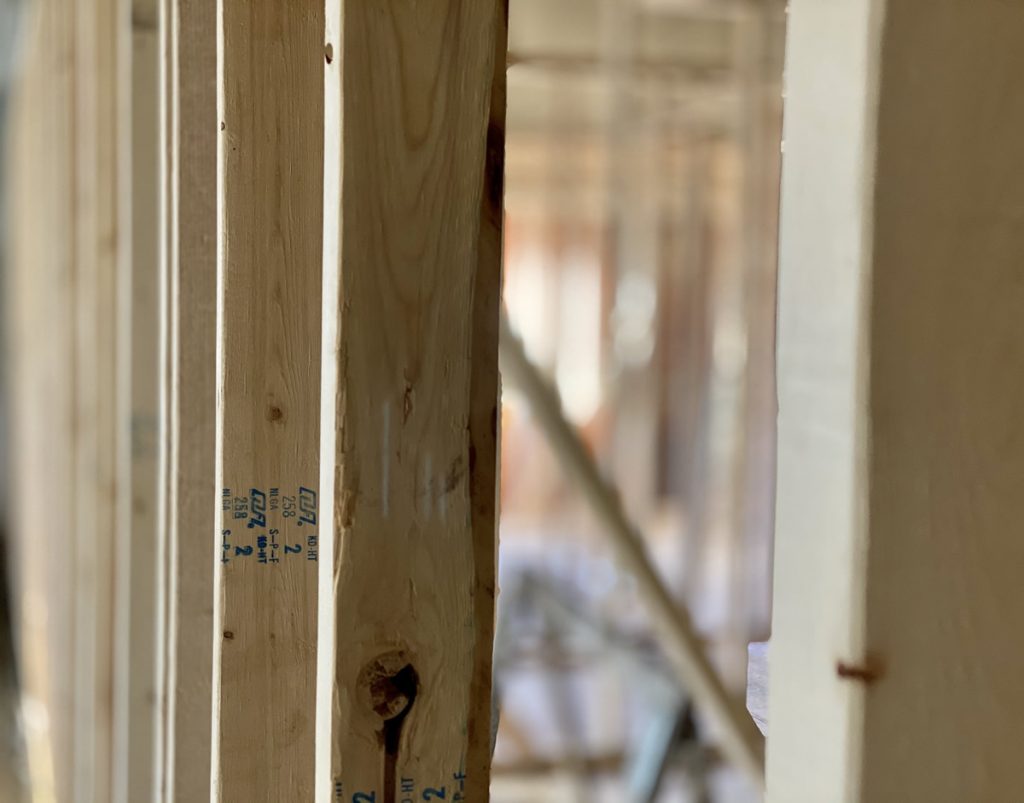It usually starts with a basement…
Where you locate your cellar will influence the costs of maintaining it in the future. It is recommended that you place a wine cellar in an area that is cool and humid. A cooling unit will be smaller and have a lower overall cost if you keep the temperature and humidity of your wine at 55 °F to 58 °F and 55-75%. You have to consider the surrounding environment in the heat gain calculation for your wine cellar. You’ll need a larger cooling unit to maintain proper conditions if the surrounding environment averages 85° compared to 65°. It will also be necessary to introduce humidity more frequently in a dry environment.

In this article, we will go over the key elements of building a wine cellar from scratch. We also recommend checking out the sommelier’s guide to cellaring wine.
Installing Studs
The wine cellar will need to be fully framed if this is new construction. Prior to installing studs, seal the concrete walls of the foundation. You will also need a vapor barrier, which will be either 6-millimeter plastic sheeting or spray foam (see ” Select Your Insulation & Vapor Barrier). If you opt for plastic sheeting, you must do that at this stage.
Continuing with this step as outlined, if you selected spray foam. With the 2×6 construction, the cooling unit size is minimized and energy efficiency is enhanced. The same concept applies to adding more insulation to your home to reduce monthly energy bills. It is important to follow all local, state, and national building codes when building your home wine cellar.

Rough-in Refrigeration
There are two types of wine coolers: split systems and ducted systems. We recommend using a ducted system as they are more efficient over the long haul. The ducts and the line set will need to be run at this point. Air handlers are usually placed in mechanical rooms. The ducts will run through the wine cellar to the air handler. It is then necessary to run the line set from the air handler to the condenser. A choice of indoor or outdoor condensers is available. The drain line and electric service must also be run.
Insulation & Vapor Barrier
Spray foam or 6-millimeter plastic sheeting and fiberglass batts are the two most common types of insulation and vapor barriers used in wine cellars. While spray foam is generally more expensive, it prevents the possibility of puncturing your vapor barrier (since no 6 mil vapor barrier is necessary when using spray foam) caused by someone inserting screws, running wire, or plumbing into or through the wine cellar wall. The spray foam will expand to fill all crevices in the enclosure, resulting in an effective seal. Non-shrinking closed cell spray foam does not compromise the enclosure. In either case, there should not be any air gaps between the insulation and the drywall.

Vapor Barrier
The wall studs should be covered with 6-millimeter plastic sheeting when you lift them into place if you will not be installing spray foam. Wrapping your ceiling joists is also necessary. Depending on the local code, some barriers must be installed on the warm side of the cellar. Spray foam insulation is highly recommended in those areas.
Wrapping & Filling Holes
To wrap and tape the seams, be sure to leave some excess sheeting at the corners. In order to reduce air movement through studs and joists, fill all holes with fire-rated penetration sealant.
Cellar Insulation
The stud and joist cavities will need to be insulated after the vapor barrier has been installed. Fiberglass batts are the most commonly used insulation. Utilizing fiberglass in a 2×4 wall cavity will provide you with an R-13 insulation value. You will receive an R-19 rating with 2×6 wall fiberglass. Insulation must be blown through the entire cavity, leaving no air pockets.
Electrical Outlets in the Wine Cellar
When building a wine cellar, outlets should be placed in the corners where the racks meet. One of the wine rack posts may obstruct the outlet if you place it outside of this area. For outlet placement in your cellar, you should follow your local building code, which will override any recommendations made by the manufacturer or distributor.
Outlet Placement for Cellar Lighting
It is The area where you want lighting does not need an electrical outlet. It will be possible for the cord to reach down to the outlet placed in the dead space from up to six feet away. Putting outlets on switches is recommended for lighting.
The Interior Walls
Following the installation of the walls, the insulation, and the vapor barrier, the next step is to cover the walls and ceiling. A high humidity environment present in your cellar will require you to use a material that can withstand it. Water-resistant drywall (also known as Green Board) is the most commonly used wall and ceiling covering based on that criterion. Most homes use the same type of drywall in their bathrooms and kitchens, so it is easily accessible. Green boards are specifically recommended for use in wine cellars and should be screwed into the walls and ceiling. Seal areas around both sides of the wine cellar with penetration sealant rated for fire.

Finishing the Drywall
It is important to run the drywall all the way to the floor. In order to keep the rack flush with the wall, there should be no molding on the walls. The base molding will be attached to the front of the wine racks.
Painting the Drywall
For best results, prime the drywall and then paint it with an exterior grade water-based paint. A wine cellar that remains unaired after oil or solvent-based paints is prone to lingering odors. Next, make sure to paint the drywall all the way to the floor.
The Wine Cellar Floor
It is important to select flooring that is resistant to high humidity when installing it in a wine cellar. In other words, you don’t want to use carpeting for a number of reasons, including the fact that it may rot. In addition, vinyl flooring should be avoided since the mastic beneath it remains damp, causing movement and buckling. Concrete can be used as a floor, just as long as it has been sealed. The most common decorative flooring options are porcelain tiles, cork, and hardwood floors. When installing wood flooring, it is recommended that you leave a half-inch gap around the perimeter to allow for expansion. You can minimize wood expansion by letting it acclimate to the wine cellar conditions for 48 hours if you have the time.

Installing the Wine Cellar Door
Install a door that is exterior grade and is weather-stripped on three sides and with a threshold and door sweep on both the bottom and top. An interior door cannot be used for this application. You are attempting to maintain a room temperature of 55°-58° F and a humidity level of 55-75%, so you need a barrier between that room and other rooms of your home. In the case of a glass door, it will need to be double-glazed to ensure insulation properties and to prevent condensation from occurring due to temperature differentials.



Pingback: Wine Storage Pros and Cons • Wine & Sommelier
Is it really that simple or does your explanation makes it look simple? Spot on again!
Pingback: How to Build a Wine Storage Facility • Chicago Wine & Sommelier School